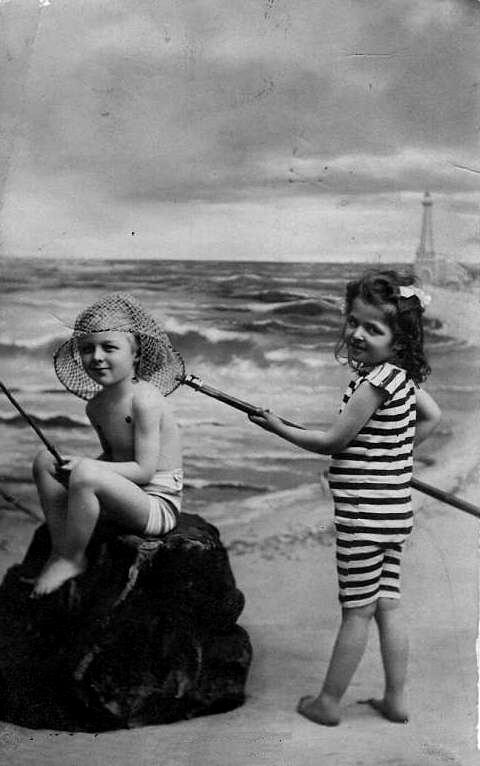
Fresh Air and Sunshine Movement: Clothing Influences

Figure 1.--We begin to see more utilitarian swimsuits after the turn of the 20th century. We suspect that the fresh air and sunshine movement associated with the sanatoria were a factor. None of the boys and fewer girls wear long stockings. Here age was a facor. We are not sure where this postcard originated, but it may be French. (It had an American back and was mailed in America, but before World WWar I many postcards were imported.) It was probably made about 1910. A reader asks, "I wonder if this post card might be English. The studio backdrop looks as if it might represent Blackpool with its iconic tower in the background."
|
|
It is difficult to assess prescisely, but surely medical endorsement of fresh air and sunshine must have affected public attitudes and in turn this would have affected attitudes toward children's clothing. The general approach to drressing children in the 19th century, after the early Napoleonic era, was to bundlke them up from head to toe. Here modesty was a major factor, but protecice cothing and warmth was also important. The idea essentially was to block out fresh air and sunshine. Of course many children went barefoot, but this was largely a poverty indicator. Dresses and pants were commonly long and when they began to be cut shorter, pantalettes and long stocking covered bare limbs. Short sleeved shirts did not exist. Interestingly after the sanatorium movement we begin to see a decline in the popularity of long stockings, This trend is much more noticeable in Europe than America. We notice knee pants becoming incresily poopular and in Europe were commonly worn with socks rather than long stockings. We also notice shorter-cut knee pahts and older boys wearing them. the same trend occurred for girls, We begin to see long stockings disappear as beachwear. Vacations to ocean beaches becamne very popular with doctors endorsing the beneficial affect of not only fresh air and sunshine, but also sea water and air. This was made poossible for the general public by rising wages and the railroads--all products of the expanding capitalist industrial economy. This was not just for the well to do, but workers as well. And the summer camp movement devloped in America to get kids out of the often polluted cities into the fresh air and sunshine The camps were usually located in undeveloed forested locations with beautiful, unpolluted lakes. Many of the camps adopted uniforms of short sleeved shirts and kneepanhts/short pats without long stockings. After the turn of the century we also notice the appearance of Barefoot Sandals. Another trend was toward casual wear, but this seems to be most pronounced after World War I. The fresh air and sunshine movenent began in the early-20th century Edwardian Era when formality in dress was still pronounced. And after World War I, short pants began to replace knee pants. Here America was an outlier. American boys did not like short pants and more commonly wore knickers. We even notie madvertisements incouraging mothers to cover up knees, especially in cold winter weather. The general trend was, however, was to dress children in clothing that exposed them to fresh air and sunshine. And the sanatorium movement must have been a factor here.
HBC

Navigate the Historic Boys' Clothing Web Site:
[Return to Main sanitoria page]
[Return to Main children's health institutions]
[Return to Main institutional page]
[Introduction]
[Activities]
[Biographies]
[Chronology]
[Clothing styles]
[Countries]
[Bibliographies]
[Contributions]
[FAQs]
[Glossary]
[Images]
[Links]
[Registration]
[Tools]
[Boys' Clothing Home]
Created: 4:48 AM 4/11/2012
Last update: 4:48 AM 4/11/2012



